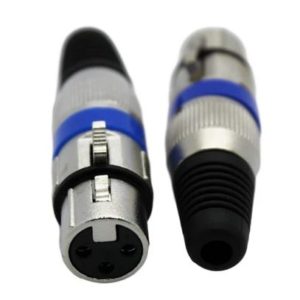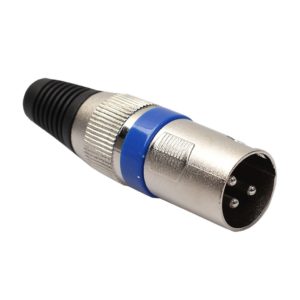Sound Connectors
A connector is a component that allows two pieces of equipment to be coupled together. Connectors provide a path for voltage, current or signals to flow freely from one device to another. Most connectors comprise of two parts, a plug and a socket. Traditionally connectors are referred to by a gender to aid identification, the male and the female.
In the live sound world there are five common cable connectors: TRS and XRL (for balanced connections); TS, RCA and banana plugs (for unbalanced connections). shaft are called the Tip, Ring, and Sleeve. TRS connectors are used wherever you need to have two conductors plus a ground (shield) in one plug.
We stock the following Sound Connectors:
XLR Connectors
XLR Connectors are most commonly used in audio applications such as in studios and stage environments, along with applications in lighting and controlling machines such as fog machines. This electrical connector is popular in professional audio applications for many reasons, but mainly because of their suitability in delivering balanced microphone and line-level signals with no loss of quality over long cable distances. The robust circular connector shape allows for reliable connection time and again.
XLR connectors are available in male or female genders. Both genders can be paired with wires which are attached to contacts on the connector. The male XLR connector features pins surrounded by a barrel sleeve to protect the small pin layout when not in use. Female XLR connectors feature a matching layout of sockets with a stepped body that mates with the male XLR barrel sleeve to make a stable connection.
XLR connectors typically have built-in push-button locking, ensuring a secure connection which may be vital in stage audio setups, or wherever the possibility of accidental disconnection is high.
For secure, durable and quality audio connections, XLR connectors are the industry standard.
Available in a range of pin counts, the most common XLR format is a standard 3 pin. This is the industry standard and can be found in almost all audio and lighting applications. Other pin counts can be used for a variety of reasons, higher pin counts can allow for a greater number of signals being transferred through the cable for applications such as controlling multi-function lighting system.
Categories
- All Categories
- Apple Divices
- Cable Management
- CCTV Accessories
- Cellphones and Accessories
- Computer & Accessories
- Computer Cables
- Computer Components
- Computer Speakers
- Computer Storage
- Computers
- Keyboards & Mice
- Laptop Accessories
- Mouse Pads
- Networking Devices
- Portable Data Storage
- USB Hubs
- Electrical
- Gaming and Accessories
- Headphones and Headsets
- Motherboards
- Photographic and Camera Accessories
- Solid State Drives
- Sound Accessories
- TV Audio & Displays
- Uncategorized
By using this website you agree to our Privacy Policy.






